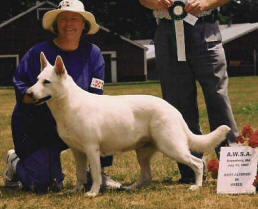
 CUSHINGS DISEASE (Hyperadrenalcorticism)
CUSHINGS DISEASE (Hyperadrenalcorticism)By Debbie Martin
March 15, 2003
Alt. CH. Hoofprint Day Light Star, O.P, TT, CGC, Therapy Dog was diagnosed with Cushing’s Disease in June of 2002. Day was 11 ½ years old at the time of diagnosis.
DAY'S SYMPTOMS:
1. Increased water consumption: Would drink the toilet dry
2. Increased hunger: Would almost attack you for food
3. Increased urination: Started to urinate in the house
DISEASE DESCRIPTION:
Cushing’s Disease, (Hyperadrenalcorticism) is caused by
a tumor on either the adrenal gland or the pituitary gland. These
tumors are usually non-cancerous.
Cushing’s Disease is the exact opposite of Addison’s Disease, but they are not related.
The tumor causes an increase in the production of “cortisol” in the body. Cortisol is a naturally occurring hormone similar to steroids. The symptoms of Cushing’s Disease are the same as if the dog was taking steroid pills.
Cushing’s Disease is a disease of middle age and old age. It is an inherited disorder. The mode of inheritance is unknown.
Cushing’s Disease often goes undiagnosed. Many of the symptoms are very gradual in onset and are often viewed as the normal result of aging. Many dogs, because of their age and other health problems, are euthanized because the assumption is made that the dog is going into kidney failure.
DISEASE PROGRESSION:
If left untreated, Cushing’s Disease can lead to muscle
weakness, an enlarged liver and a sagging, swollen looking abdomen from
the enlarged liver and loss of muscle tone. There may be increased
panting and lung disorders, such as blood clots, may occur.
There is an increased chance that a dog with Cushing’s Disease may develop Diabetes.
The disease can also cause neurological symptoms such as seizures, stiffness of gait and walking “knuckled” over on the feet.
Hair will thin on the body to the point of baldness.
Skin lesions and skin infections can also develop.
METHOD OF DIAGNOSIS:
A complete biochemical profile was run. Day had a very high amylase
level which can indicate pancreatic disease. She also had a high
Alkaline Phosphatase Level which can be an indicator of Cushing’s
Disease. She had a C.B.C. (complete blood count) which was normal.
Her urinalysis showed that her kidneys were not concentrating her urine. This can be an indicator for Kidney Disease or Cushing’s Disease.
We then did a “water deprivation” test to see if her kidneys could concentrate her urine when she was not drinking a lot of water.
The urinalysis after the water deprivation test, showed that her urine was more concentrated, but still not within normal ranges. This could be an indicator of Diabetes Insipidis.
RULE OUTS:
She had further blood tests to rule out Pancreatic Disease. These tests were normal.
A kidney protein ratio test was done to determine how well her kidneys were functioning. This test was within normal ranges.
A test for diabetes insipid was done. This involved putting drops in her eyes for 4 days and then drawing more blood samples. This test was normal.
An ACTH stimulation test was done and confirmed the diagnosis of Cushing’s Disease.
She also had an abdominal and cardiac ultrasound done to rule out cancer.
TREATMENT:
If the tumor is on the adrenal glands, surgical removal can be considered.
There are several drugs that can be used to treat Cushing’s Disease. Many of these drugs must be carefully given and blood tests must be repeated on a regular basis to prevent causing Addison’s Disease.
At this time, I have chosen to treat Day with a drug called Anipryl, which is a drug used to help “doggy dementia”. This drug is very safe and has no side effects. She has been on this drug at a very low dose for 8 months. The symptoms of Cushing’s Disease have returned, so her dose has been doubled.
The cost of each pill is approximately $4.00 and she is now on two pills a day.
The cost of obtaining a diagnosis was approximately $700.00. This also included the ultrasound.
The diagnosis does not need to be so expensive, but in view of some of the discrepancies in her blood work and urinalysis, I chose to explore each possible rule out.
The minimum blood work necessary to obtain a diagnosis of Cushing’s Disease is the ACTH stimulation test which is approximately $60.00. A biochemical profile, CBC and urinalysis should be performed also and will cost approximately $130.00 to $150.00. The total minimum cost will be $200.00 to $250.00.
COMMENTS:
At this time, Day is 12 years old. She is still athletic and energetic in spite of her disease.
This is a
disease that cannot be cured, but can be controlled. Of all the
diseases a dog her age could have, I consider us lucky to have this one.